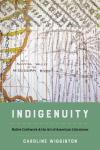Indigenous Peoples Studies
| Native Apostles: Black and Indian Missionaries in the British Atlantic World | ||
| Faith and Boundaries: Colonists, Christianity, and Community among the Wampanoag Indians of Martha's Vineyard, 1600-1871 | What did it take for New England Indians and colonists to live alongside one another in peace? Was it possible for native communities to maintain distinct cultural and geographic boundaries after the English had seized the balance of power? In this presentation, David J. Silverman answers these questions by using Martha's Vineyard as a case study. He also shows that some island Wampanoag communities, such as Aquinnah (or Gay Head), lasted because their members were willing to adapt in order to preserve their land base and community ties. |
|

|
Reading Territory: Indigenous and Black Freedom, Removal, and the Nineteenth-Century State | The formation of new states was an essential feature of US expansion throughout the long nineteenth century, and debates over statehood and states' rights were waged not only in legislative assemblies but also in newspapers, maps, land surveys, and other forms of print and visual culture. Assessing these texts and archives, Kathryn Walkiewicz theorizes the logics of federalism and states' rights in the production of US empire, revealing how they were used to imagine states into existence while clashing with relational forms of territoriality asserted by Indigenous and Black people. |

|
The Indians’ New World Revisited | James H. Merrell will recount how he found his way into, or, as he puts it, “more accurately, stumbled upon,” The Indians’ New World and how this Bancroft Prize-winning book and the field have fared in the decades since the work appeared. |

|
Indigenuity: Native Craftwork and the Art of American Literatures | For hundreds of years, American artisanship and American authorship were entangled practices rather than distinct disciplines. Books, like other objects, were multisensory items all North American communities and cultures, including Native and settler colonial ones, regularly made and used. All cultures and communities narrated and documented their histories and imaginations through a variety of media. All created objects for domestic, sacred, curative, and collective purposes. |

|
Removal in the Archive: Nationalist Mythmaking and Indigenous Dispossession | As the United States and Mexico transformed from European colonies into independent nations—and before war scarred them both—antiquarians and historians compiled and interpreted archives meant to document America’s Indigenous pasts. These settler-colonial understandings of North America’s past deliberately misappropriated Indigenous histories and repurposed them and their material objects as "American antiquities," thereby writing Indigenous pasts out of U.S. and Mexican national histories and national lands and erasing and denigrating Native peoples living in both nascent republics. |
| Making Past and Place in the Northeast after King Philip's War (1675-78) |